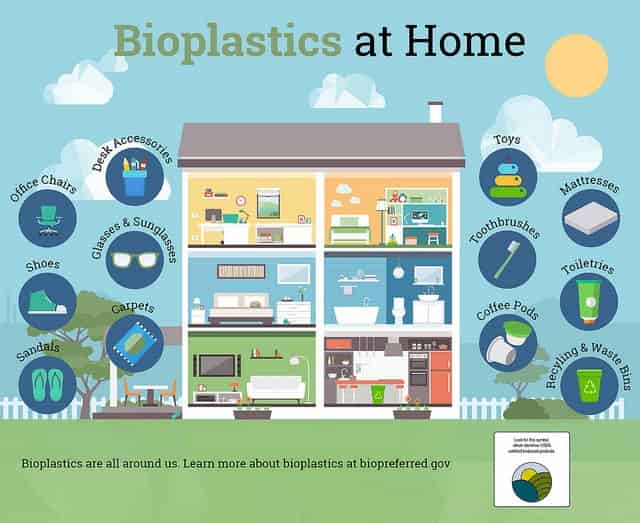Industrial Revolution Plastics Biobased bioplastics - Arhive
A New Industrial Revolution for Plastics Industrial Revolution Plastics Biobased bioplastics

Remember “plastics make it possible!” – the advertisement campaign from the 1980s? There’s a new kind of plastic in town 30 years later – bioplastics.
Biobased bioplastics are plastics made from renewable resources – agricultural feedstocks such as corn, soybeans, or sugarcane. The starches, oils, and sugars from these feedstocks are extracted, modified, and used as the chemical building blocks for these new bioplastic products.Industrial Revolution Plastics Biobased bioplastics
This is valuable because these feedstocks are sources of “new” carbon because of their renewability.Industrial Revolution Plastics Biobased bioplastics
Petroleum/oil-based products contain “old” carbon. The amount of new carbon in a product can be an important measurement for the product’s sustainability.
Bioplastics can also be made from used cooking oil, straw, food waste, and natural gas. These second-generation feedstocks used for bioplastic products are gaining in popularity.
Bioplastics may also be defined and identified by their end-of-life attributes or benefits. One of these is compostable bioplastic, designed to biodegrade during industrial composting into biomass, water, and carbon dioxide.Industrial Revolution Plastics Biobased bioplastics
Diversion of organic wastes to composting is expanding across the country – there are currently 4,700 industrial composting facilities in the U.S. that compost yard trimmings, food scraps, biosolids, and bioplastics, etc.
These composting facilities manufacture valuable soil amendments for use in agriculture and other applications.Industrial Revolution Plastics Biobased bioplastics
It’s important to note that bioplastic products may be biobased and/or biodegradable, as these attributes do not mean the same thing.
Traditional oil-based plastics – a part of nearly everything we touch and use each day from machine parts, computers, toys, to product packaging – are made from nonrenewable petroleum. 300 million metric tons of these plastics are produced globally per year.
More and more companies are processing renewable feedstocks into chemical components and biobased resins, and more companies are making bioplastic products and packaging.
While bioplastics currently make up less than 1 percent of the traditional plastics market, the opportunity for future global growth is large.
Growth in bioplastics from 2013-2017 is 29 percent; global growth in bioplastics is expected to grow at a pace of 18 percent between 2017 – 2022.
As agricultural crop yields continue to increase, this kind of bioplastic product and market development is a promising avenue for the use of these commodities.
USDA offers a range of support and programs to increase the research, development and buyer/consumer awareness of bioplastics.
Agricultural Research Service (ARS) scientists developed a way for crop residue enzymes (from cornstalks, straw, and sugarcane bagasse) to work more effectively to convert sugars into compounds.
Those compounds are the building blocks in the sustainable manufacture of nylon plastics. Heat-resistant and nonconductive, nylon plastics are used for screws, nuts, bolts, and other products in the manufacture of electronics.
Much of the food we eat is wrapped in oil-based plastic packaging, which while reducing spoilage, and food waste, is not traditionally biobased or compostable.
ARS scientists developed a biobased, compostable, and edible film from casein, a milk protein made from expired milk.Industrial Revolution Plastics Biobased bioplastics
The new film protects food from damaging oxygen 500 times more effectively than petroleum-based plastic, making it significantly better at keeping foods fresher for even longer periods of time.Industrial Revolution Plastics Biobased bioplastics
The milk-based film is versatile and can be made into pouches that dissolve in hot water. This cost-effective, biobased, and compostable milk-protein film is currently being tested by a major U.S. soup company.
The global bioplastic packaging market is expected to grow at a pace of 18 percent between 2017-2025.
USDA’s BioPreferred Program works to increase the purchase and use of biobased products through federal procurement and a certification and labeling initiative.
The program helps federal agencies meet statutory mandates to increase the specification and purchase of biobased products, including bioplastics where applicable.
The program’s USDA Certified Biobased Product label is a market development initiative to increase consumer and buyer recognition, and the purchase of bioproducts.
Intermediate chemical manufacturers, bioplastic resin manufacturers, and global consumer product companies launching new bioplastic products may third-party test and certify the new carbon content of their bioplastics.
After doing so, these products are identified as USDA Certified Biobased Products and feature a label for easy identification and purchase by buyers and consumers.
Since 2011, the first year of USDA’s certification initiative, more than 100 bioplastic resins are identified as USDA Certified Biobased Products.
Bioplastic resin is the upstream ingredient that is manufactured into the 200 USDA Certified Biobased packaging and bioplastic products currently on the market.
There are numerous benefits of bioplastics. Bioplastics help reduce fossil fuel use, lessen the carbon footprint of the conventional products they replace, and, in aggregate use, may mitigate the effects of climate change.
Compostable bioplastics reduce municipal landfill waste by facilitating the diversion of food scraps and nonrecyclable food-soiled packaging. Bioplastics can provide the same, if not better, performance than traditional oil-based plastics. Now, bioplastics are making it possible.
